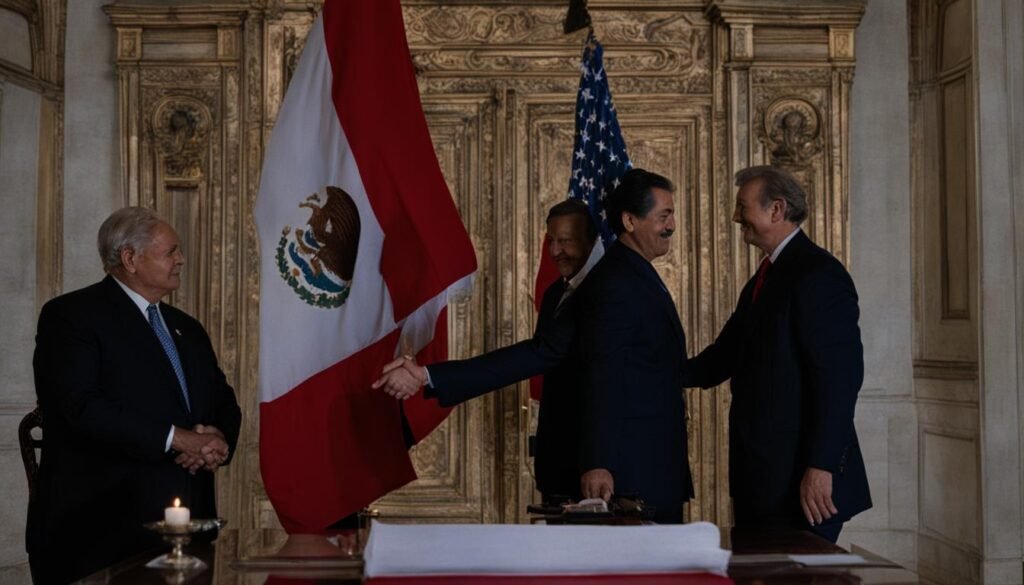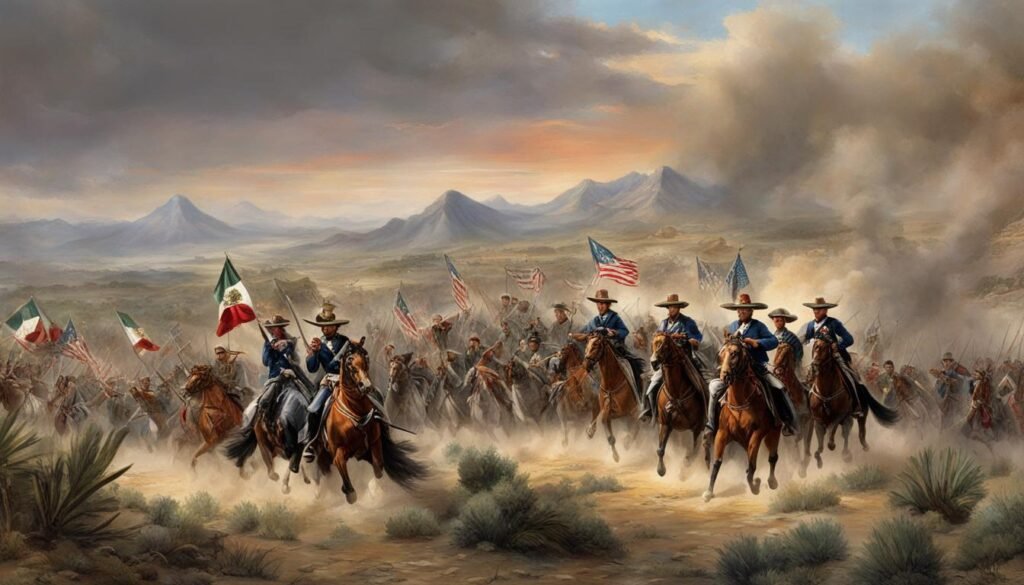The Mexican-American War, fought from April 1846 to February 1848, was a defining moment in the history of the United States and Mexico. Primarily centered around disputed territories, this war had a significant impact on both nations and shaped the course of American expansionism and sectional tensions over slavery. Let’s delve into the key facts and explore the lasting implications of this conflict.
Key Takeaways:
- The Mexican-American War was fought between the United States and Mexico from April 1846 to February 1848.
- It was primarily fought over disputed territories, with the United States ultimately gaining more than 500,000 square miles of Mexican territory.
- Key figures in the war included General Winfield Scott of the United States and Mexican President Antonio López de Santa Anna.
- The war triggered debates over the expansion of slavery, intensifying sectional tensions within the United States.
- The Treaty of Guadalupe Hidalgo ended the war, resulting in the significant cession of Mexican territory to the United States.
Causes of the Mexican-American War
The Mexican-American War was a result of several causes that escalated tensions between the United States and Mexico. These causes include:
- The Annexation of the Republic of Texas: The United States’ annexation of Texas in 1845, which was previously an independent republic, was viewed by Mexico as a violation of its territorial claims. This led to increased hostility between the two nations.
- Negotiation Failures: President James K. Polk of the United States attempted to purchase additional lands from Mexico to facilitate westward expansion. However, negotiations failed as Mexico refused to sell the desired territories, such as New Mexico and California.
- Military Presence: In response to failed negotiations, President Polk ordered American troops to establish a military presence in the disputed region of the Rio Grande, which was claimed by both Mexico and the United States.
- Border Skirmish: A border skirmish between Mexican and American forces along the disputed Rio Grande region resulted in casualties on both sides. This incident further escalated tensions and led to the declaration of war by the United States Congress in 1846.
- Expansion of Slavery: The annexation of new territories raised concerns among abolitionists, as it threatened to upset the delicate balance between free and slave states. The expansion of slavery became a major point of contention during the war.
These causes, combined with other factors, ultimately led to the outbreak of the Mexican-American War, marking a significant chapter in the history of both nations.
Key Events in the Mexican-American War
The Mexican-American War was a significant conflict that witnessed several key events and major battles. These events played a crucial role in shaping the outcome of the war and its impact on both the United States and Mexico. Here are some of the major battles that took place during the war:
- Battle of Buena Vista
- Battle of Cerro Gordo
- Battle of Contreras
- Battle of Palo Alto
- Battle of Chapultepec
These battles saw the United States achieve significant victories over the Mexican forces, ultimately leading to the capture of Mexico City by General Winfield Scott. Each battle marked a strategic moment in the war and contributed to shaping the final outcome.
The timeline of the Mexican-American War spanned from April 1846 to February 1848. Throughout this period, various military engagements and strategic maneuvers occurred, each playing a part in the progression of the conflict. These key events and battles are crucial to understanding the sequence of events and the significance of the Mexican-American War in shaping the history of both nations involved.
Illustrating the Battle of Buena Vista:

Impact of the Mexican-American War
The Mexican-American War had a significant impact on both the United States and Mexico, shaping the course of history and leaving lasting repercussions.
1. Territorial Expansion and Manifest Destiny
For the United States, the war resulted in a substantial territorial expansion. Through the Treaty of Guadalupe Hidalgo, the United States acquired more than 500,000 square miles of Mexican territory, including present-day California, Nevada, Utah, Arizona, New Mexico, and parts of Colorado, Wyoming, and Oklahoma. This significant land gain solidified the concept of Manifest Destiny, the belief that it was America’s divine right to expand its territory from coast to coast.
2. Demographic and Cultural Changes
The acquisition of Mexican territories brought about demographic and cultural changes in the United States. The influx of new lands and the discovery of gold in California sparked a population boom, attracting settlers from across the country and around the world. This influx of diverse populations played a crucial role in shaping the multicultural fabric of the American Southwest.
3. Devastating Consequences for Mexico
On the other hand, the Mexican-American War had devastating consequences for Mexico. The loss of vast territories severely impacted the nation’s territorial integrity and sovereignty. It resulted in the cession of valuable resources and pushed Mexico into a state of severe economic and political distress. The war exacerbated political instability within Mexico and hindered its ability to recover and develop as a nation.
4. Intensified Sectional Tensions
The Mexican-American War also intensified sectional tensions within the United States, particularly over the issue of slavery in the newly acquired territories. The question of whether these territories would be free or allow the expansion of slavery became a heated and divisive topic. These tensions eventually contributed to the outbreak of the American Civil War in 1861.
Mexican-American War Summary – Treaty of Guadalupe Hidalgo
The Mexican-American War came to a close with the signing of the Treaty of Guadalupe Hidalgo in 1848. This historic treaty marked a significant moment in the aftermath of the Mexican-American War and set the stage for the future of both nations involved.
Under the terms of the treaty, Mexico agreed to cede a substantial portion of its territory to the United States. This included present-day California, Nevada, Utah, Arizona, New Mexico, and parts of Colorado, Wyoming, and Oklahoma. The transfer of these territories had far-reaching consequences, shaping the geopolitical landscape of North America.
In exchange for the territory, the United States agreed to pay Mexico $15 million and assume the responsibility for certain claims made by American citizens against Mexico. The financial compensation and assumption of liabilities aimed to resolve outstanding issues between the two nations.
Furthermore, the Treaty of Guadalupe Hidalgo established the Rio Grande as the southern border between the United States and Mexico. This delineation of the border aimed to bring clarity and stability to the region.
The aftermath of the war posed significant challenges for the United States as it grappled with the process of integrating the newly acquired territories. The question of how to govern and incorporate these vast regions into the existing fabric of the United States society would shape future policies and debates.

The Treaty of Guadalupe Hidalgo was both a reflection of the consequences of the Mexican-American War and a pivotal moment in history. Its impact on the geopolitical landscape of North America continues to resonate to this day.
Mexican-American War Key Players
The Mexican-American War featured prominent individuals from both the United States and Mexico who played pivotal roles during the conflict. Understanding the contributions and actions of these key players is essential to gaining a comprehensive overview of the war.
In the United States, President James K. Polk played a significant role in initiating and overseeing the war. His policies and decisions, such as the annexation of Texas, fueled the tensions and ultimately led to armed conflict. Polk’s determination to expand American territory played a crucial role in the war’s outcome.
On the military front, two key figures, General Winfield Scott and General Zachary Taylor, emerged as instrumental leaders. General Scott, who later became the 1852 presidential candidate for the Whig Party, devised and executed a masterful military campaign that culminated in the capture of Mexico City. General Taylor, renowned for his victories at Palo Alto and Buena Vista, emerged as a national hero and later served as the 12th president of the United States.
In Mexico, President Antonio López de Santa Anna played a central role in the war. Although he faced internal political challenges and criticism, Santa Anna demonstrated strategic prowess as a military leader. Despite facing setbacks, his command during various battles showcased his determination and resilience.
Throughout the conflict, the actions and decisions of these key players shaped the course of the war and its eventual outcome. Understanding their roles and contributions helps shed light on the intricacies and complexities of the Mexican-American War.
Conclusion
The consequences of the Mexican-American War were profound, shaping the course of history for both the United States and Mexico. For the United States, the war marked a significant milestone in its territorial expansion and solidified its belief in Manifest Destiny. The acquisition of vast territories, including present-day California, Nevada, Arizona, New Mexico, and parts of other states, brought about demographic and cultural changes that continue to shape the nation today.
However, the war also heightened sectional tensions in the United States, particularly over the issue of slavery in the newly acquired territories. The debate over the expansion of slavery would eventually contribute to the outbreak of the Civil War, further dividing the nation. The Mexican-American War thus served as a precursor to the challenges and conflicts that lay ahead in America’s quest for expansion.
In Mexico, the consequences of the war were devastating. The loss of vast territories to the United States led to a deepened sense of national humiliation and political instability. The war exposed the weaknesses and divisions within Mexican society, exacerbating existing socioeconomic disparities and undermining the country’s stability. The Mexican-American War significantly altered the geopolitical landscape and power dynamics in North America.
Understanding the causes, key events, and impact of the Mexican-American War is crucial for comprehending the complexities of American history and its relationships with neighboring nations. The consequences of this conflict continue to shape the present-day social, cultural, and political landscape of both the United States and Mexico.
FAQ
What were the main causes of the Mexican-American War?
The Mexican-American War was primarily caused by the disputed territories between the United States and Mexico, with the annexation of Texas by the United States and the failed negotiations for purchasing additional lands from Mexico being key factors.
What were the key events in the Mexican-American War?
The Mexican-American War saw several major battles, including the Battle of Buena Vista, the Battle of Cerro Gordo, the Battle of Contreras, the Battle of Palo Alto, and the Battle of Chapultepec. These battles shaped the outcome of the conflict and led to the capture of Mexico City by General Winfield Scott.
What was the impact of the Mexican-American War?
The Mexican-American War had far-reaching consequences. For the United States, it resulted in significant territorial expansion, solidified the concept of Manifest Destiny, and intensified sectional tensions over the issue of slavery. In Mexico, the war led to the loss of vast territories and political instability.
What was the Treaty of Guadalupe Hidalgo and how did it end the Mexican-American War?
The Treaty of Guadalupe Hidalgo, signed in 1848, ended the Mexican-American War. Under the treaty, Mexico ceded a significant portion of its territory to the United States, including present-day California, Nevada, Utah, Arizona, New Mexico, and parts of Colorado, Wyoming, and Oklahoma.
Who were the key players in the Mexican-American War?
Notable figures in the Mexican-American War include President James K. Polk, General Winfield Scott, General Zachary Taylor from the United States, and Mexican President Antonio López de Santa Anna. These individuals played crucial roles in shaping military strategy and leading their respective forces.
What were the consequences of the Mexican-American War?
The Mexican-American War had significant consequences for both the United States and Mexico. For the United States, it marked a milestone in territorial expansion, intensified sectional tensions, and laid the groundwork for future conflicts leading up to the Civil War. In Mexico, the war led to the loss of territories and deepened political instability.







